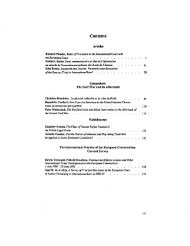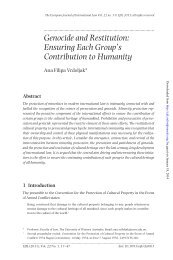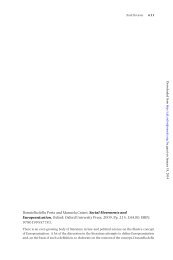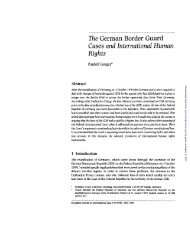Intangible Cultural Heritage - European Journal of International Law
Intangible Cultural Heritage - European Journal of International Law
Intangible Cultural Heritage - European Journal of International Law
You also want an ePaper? Increase the reach of your titles
YUMPU automatically turns print PDFs into web optimized ePapers that Google loves.
106 EJIL 22 (2011), 101–120<br />
Executive Board to launch, in 1998, 20 the Programme <strong>of</strong> the Proclamation <strong>of</strong> Masterpieces<br />
<strong>of</strong> the Oral and <strong>Intangible</strong> <strong>Heritage</strong> <strong>of</strong> Humanity. The purpose <strong>of</strong> this Programme,<br />
which represented the immediate predecessor to the UNESCO Convention<br />
for the Safeguarding <strong>of</strong> <strong>Intangible</strong> <strong>Cultural</strong> <strong>Heritage</strong> (CSICH), 21 was to honour the most<br />
remarkable expressions <strong>of</strong> ICH, selected on the basis <strong>of</strong> the nominations presented<br />
by UNESCO member states. It encompassed a definition <strong>of</strong> ICH drafted by a group <strong>of</strong><br />
UNESCO experts during the first experts’ meeting <strong>of</strong> the negotiations <strong>of</strong> the CSICH, 22<br />
the formulation <strong>of</strong> which is very close – even though, maybe, a little wider in its scope –<br />
to that used in the final text <strong>of</strong> the Convention. 23 Its rationale was based on the<br />
understanding that<br />
[t]he oral and intangible heritage has gained international recognition as a vital factor in cultural<br />
identity, promotion <strong>of</strong> creativity and the preservation <strong>of</strong> cultural diversity. It plays an<br />
essential role in national and international development, tolerance and harmonious interaction<br />
between cultures. In an era <strong>of</strong> globalization, many forms <strong>of</strong> this cultural heritage are<br />
in danger <strong>of</strong> disappearing, threatened by cultural standardization, armed conflict, the harmful<br />
consequences <strong>of</strong> mass tourism, industrialization, rural exodus, migration and environmental<br />
deterioration. 24<br />
The Masterpieces <strong>of</strong> the Oral and <strong>Intangible</strong> <strong>Heritage</strong> <strong>of</strong> Humanity were selected<br />
according to six criteria, which were applied with a view to ascertaining that those<br />
masterpieces meet the requirements <strong>of</strong> ‘a strong concentration <strong>of</strong> ICH <strong>of</strong> outstanding<br />
value’ or ‘a popular and traditional cultural expression <strong>of</strong> outstanding value from a<br />
historical, artistic, ethnological, linguistic or literary point <strong>of</strong> view’. 25 Although these<br />
terms <strong>of</strong> reference were based on the concept <strong>of</strong> ‘outstanding value’, such exceptional<br />
character existed when the nominations, inter alia, ‘give wide evidence <strong>of</strong> their roots<br />
in the cultural tradition or cultural history <strong>of</strong> the community concerned’ and ‘demonstrate<br />
their role as a means <strong>of</strong> affirming the cultural identity <strong>of</strong> the peoples and cultural<br />
communities concerned’. 26 In addition, the ‘subjective’ orientation <strong>of</strong> the criteria<br />
in point was demonstrated by the Guide for the Presentation <strong>of</strong> Candidature Files <strong>of</strong><br />
20<br />
See Dec. 155 EX/3.5.5, UNESCO, Executive Board, 155th Session, Decisions adopted by the Executive<br />
Board at its 155th Session, Doc. 155 EX/Decisions <strong>of</strong> 3 Dec. 1998, available at: http://unesdoc.unesco.<br />
org/images/0011/001142/114238e.pdf [Last accessed 15 January 2011], at 8.<br />
21<br />
Adopted by the UNESCO General Conference on 17 Oct. 2003; the full text <strong>of</strong> the Convention is available at:<br />
http://portal.unesco.org/en/ev.php-URL_ID=17716&URL_DO=DO_TOPIC&URL_SECTION=201.html<br />
(last accessed 6 Oct. 2010).<br />
22<br />
The meeting took place in Grinzane Cavour, Turin, Italy, from 14 to 17 Mar. 2001. The definition in<br />
point reads as follows: ‘peoples’ learned processes along with the knowledge, skills and creativity that<br />
inform and are developed by them, the products they create, and the resources, spaces and other aspects<br />
<strong>of</strong> social and natural context necessary to their sustainability; these processes provide living communities<br />
with a sense <strong>of</strong> continuity with previous generations and are important to cultural identity, as well as<br />
to the safeguarding <strong>of</strong> cultural diversity and creativity <strong>of</strong> humanity’ (document on file with the author).<br />
23<br />
See infra, sect. 3.<br />
Downloaded from http://ejil.oxfordjournals.org/ by guest on January 18, 2014<br />
24<br />
Document on file with the author.<br />
25<br />
See www.unesco.org/bpi/intangible_heritage/backgrounde.htm (last accessed 6 Oct.r 2010).<br />
26<br />
Ibid.








